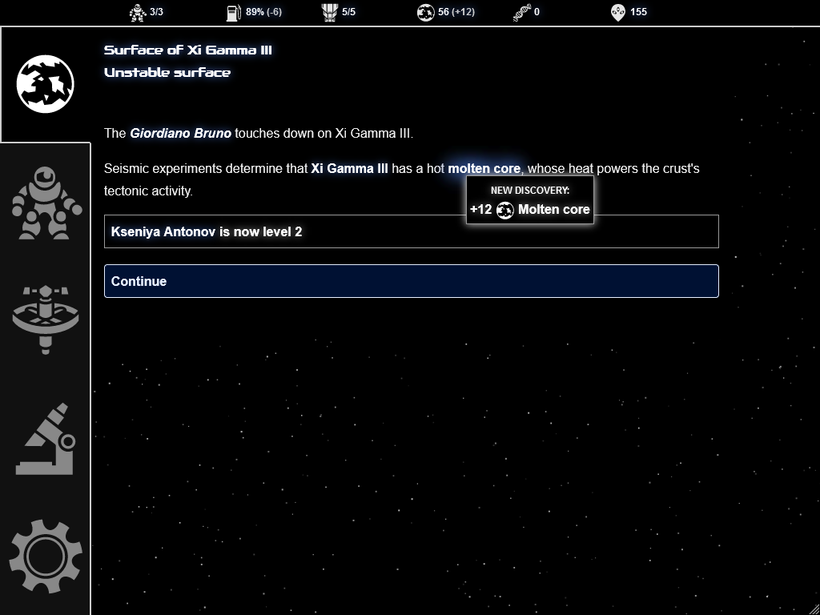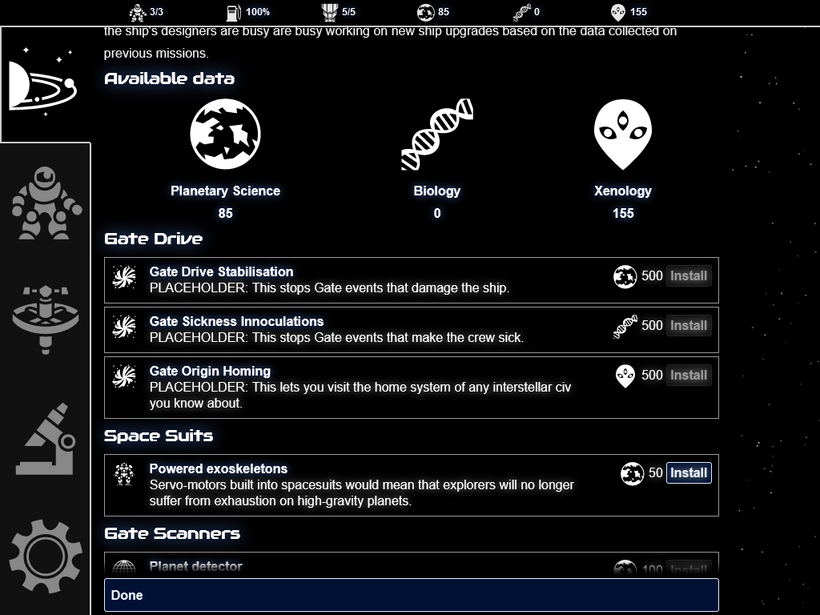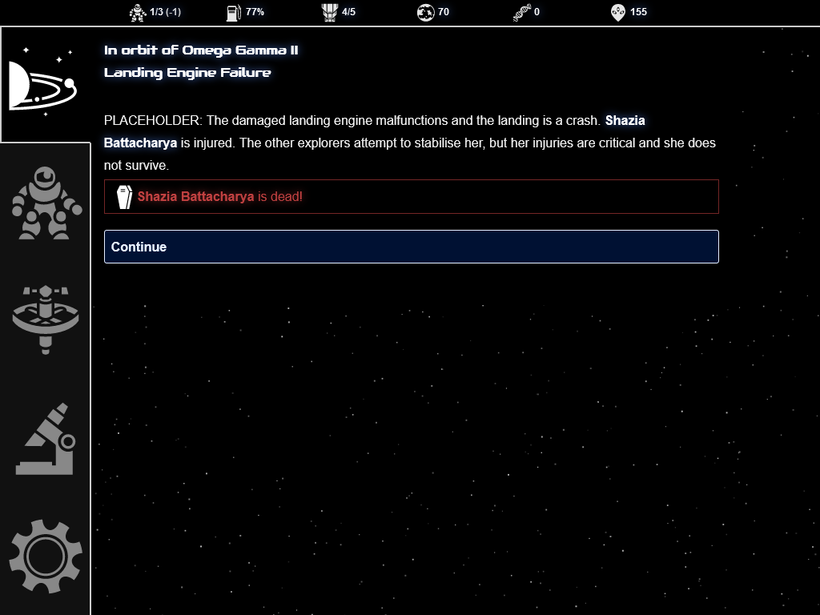The other day I completed a full playthrough of Beyond the Chiron Gate, and I found that–despite a ton of bugs (noticeable, but not game breaking), lots of placeholder text, and the fact that nothing really surprised me because I wrote it–I actually enjoyed it. So I’m feeling pretty good about the state of the game right now.
Here’s what the game looks like now:

Interface changes
I’ve reworked the interface to put the important stats along the top, and have more information shown on the main screen. From left to right: crew, fuel, hull integrity, and the three types of data: planetary science, biology, and xenology.
Gone are the big notification boxes for new discoveries. Instead, you can now mouse-over highlighted text to get a tooltip showing how much data you got and of what kind. (Screenshots don’t capture the mouse pointer, so you’ll have to take my word for it that I was mousing over “molten core” when I took that one.) I found that the notification boxes were drawing the eye away from the text and felt a big overwhelming, especially when there were a lot of them appearing at once, which happened when you investigated life or a civilisation. Integrating the discovery notifications into the text makes the whole experience smoother, matches how planet view works, and makes it feel…well, more like a text-based game.
You can mouse over other things too! Mousing over a crew member’s name shows you their class, level, and any conditions affecting them. Mousing over the numbers along the top tells you what they mean and gives more detail if more is to be had: a quick icon-based summary of your crew if you mouse over the crew icon, or a list of all the damage the ship has if you mouse over the armour icon. There isn’t any more information to show in the case of fuel and data, but the tooltip clarifies what the icons mean.



Data changes
Regular readers might be wondering: what happened to the fourth data type, Wormhole data? The answer is that I’ve completely removed it from the game! Things that used to give it have been removed or now give a different data type, and the upgrades it used to to buy have been removed or replaced.
Wormhole data existed in order to buy upgrades that let you have progressively better control of the Gate network, and eventually visit the Gatebuilders’ system and win the game. But as I playtested I found that it felt too disconnected from the rest of the game, and broke away from the “realistic space exploration” theme of the game by being essentially a made-up kind of science. The control of the Gate network that it bought you also felt like something it was annoying not to have, rather than something that felt good to unlock. In particular, all the scanners that told you about destination systems were useless without the first Gate control upgrade, which could take a long time to get.
So, the Gate control upgrades are now gone. You can now choose between five destination systems right away, and you start off being able to tell the star type of each destination system. The Gatebuilders’ home system still requires expensive upgrades to unlock, but there are now three of them, one for each data type.

Like practically everything I’ve added this month, the descriptions of these are currently placeholder text. But the idea is that each one offers its own benefit (protection from certain wormhole events for the first two, and the ability to visit alien home systems for the third), and visiting the Gatebuilders’ home system requires all three. (If you have Gate Origin Homing but not the first two, you can try to go to the Gatebuilders’ system but you get a special event that sends you back home.)
Because working towards the Gatebuilders’ system no longer has its own data type, you’re faced with a more interesting choice: do you spend your data on upgrading the ship, or save it up to buy the victory upgrade?
Other balancing changes
Also visible in the screenshots above is that you now start with only three crew slots, not four. I was actually really surprised at how much more tense this made the game feel, and how much more interesting it made the initial choice of which crew members to take.
There’s still a crew expansion upgrade for each data type, but there are only three data types now, so if you get them all, the maximum crew size is six. (My goal for balancing is that you probably won’t get all three of these upgrades in a given playthrough.)
I’ve also changed fuel into a percentage. You lose a flat amount for each interplanetary journey, and an amount depending on a planet’s gravity when you land. Making fuel more granular this means I can use fuel loss as a hazard in events.
System scanners (e.g. detecting which planets have life) now require you to buy the corresponding Gate scanners first (e.g. detecting which systems have planets with life), rather than the other way round. This may not make sense from a science point of view, but I found that it greatly improved the game: rather than heading straight for the life icon and being disappointed if there wasn’t one, I was in a situation where I knew there was life to be found somewhere in the system but I still had to guess where to look for it.
More events
This month I’ve also added a bunch more events. Almost all of them are just placeholder text for the moment, because I wanted to see how they affect the game balancing before I finish filling them in; I don’t want to spend time writing events I’ll eventually cut. The events include more ways to unlock ship upgrades, and things that can go wrong if the ship has taken damage. Trying to keep exploring with a damaged ship is now much more tense.

Extinct life
Finally, it’s now possible to find planets where life has gone extinct. You can’t learn as much from an extinct ecosystem as you can a living one, although you can investigate the reason it went extinct. And of course events where the native life tries to eat you don’t trigger on planets where life is extinct. (At least I’m pretty sure they don’t, but alien zombie attacks was a bug that kept popping up.)

Future plans
That’s all for this month. Next month I’m going to focus on fixing bugs, tweaking the balancing some more, adding more events, and filling in placeholder text.
If all goes well, at the end of July I’m hoping to have a fully playable, relatively bug-free, minimum viable game that I can ask people to playtest. After that I still want to add a lot more content, as well as fixing any issues the playtest raises, but I’m feeling confident about getting the game finished and launched late 2021.
